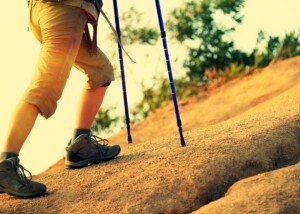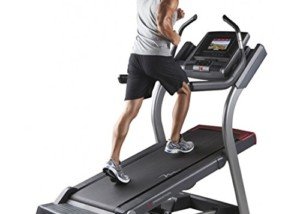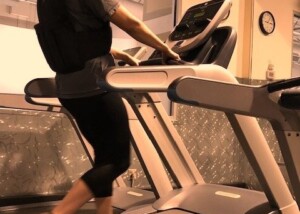It’s easy to say that the cause of low back ache after hiking is due to being “out of shape.”
But incorrect use of a treadmill can be a contributing factor.
Let’s assume that there’s nothing structurally wrong with the bones in your back or the nearby nerves.
In other words you have NOT been diagnosed with any of the following:
• Herniated disc or “pinched nerve”
• Nerve compression
• Sciatica
• Spinal stenosis
• Kyphosis
• Lordosis
• Spondylolisthesis
• Any low back injury
• Any medical issue that can cause low back pain
Yet here you are, feeling some aches in your back after completing a hike.
Or, it’s the day after the hike that you really feel some hurting going on in your lumbar back.
Let’s also assume that for your hikes, you’re NOT carrying a backpack. This article is about hiking without the backpack.
Incorrect Use of a Treadmill
What some people do, to prepare for hiking season, is walk on a treadmill set to an incline.
This is a good way to help prepare for hiking – unless you hold onto the treadmill.
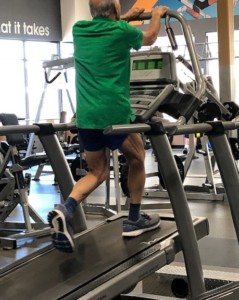
Holding on at an incline is extremely common and is done by both men and women – of all ages, all body types, all heights.
It’s a universal misunderstanding of how to properly use a treadmill.
Holding on while using an incline is absolutely NOT the same as walking up a hill outdoors.
• Holding on will not prepare you.
• Instead, it’ll betray you.
Why Holding onto a Treadmill will Sabotage Developing Hiking Fitness
When you walk anywhere outside, whether on a flat surface, up steps, up a mildly inclined hill, a moderately steep trail or a very steep trail or tundra – your torso is vertical.

If you were to stand still on an incline with your legs straight and arms hanging at your sides, your entire body would be vertical.
When fatigue kicks in as you climb, you may find yourself lurching forward somewhat, BUT – your legs will stay vertical right at the point where they straighten as the other leg prepares to take a stride.
The steeper the grade, the smaller the angles that are created by your flexing feet, knees and hips as you walk.
To put it another way, the steeper the trail, the more your ankle, knee and hip joints need to flex.
And this is why walking on inclines is more difficult than walking on flat areas.
Low Back Muscles Assist with Incline Walking
When you stand normally on a flat grade, the angle formed by ankle flexion is 90 degrees.
As you walk, this 90-degree angle is, for the most part, maintained.
The higher the incline (or steeper the hill), the smaller this angle becomes.
If you attempt to maintain a 90-degree bend at your ankles, while standing on a hill, what will happen?
If you were somehow able to keep your body straight like a ruler, while maintaining that 90-degree angle on a hill – you’d fall backwards.
So what stops you from falling backwards when hiking up hills?
Your low back muscles (erector spinae). These muscles, which are designed for spinal stabilization, work harder than usual to prevent you from falling backwards.
The steeper the hike, the more these low back muscles are engaged or recruited.
Holding onto an Inclined Treadmill Takes Work Away from the Low Back Muscles
When people hold onto an inclined treadmill, many — not all — tilt back at the same angle as the incline, cancelling out the incline’s effect.
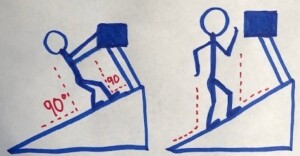
Tilting back cancels out the incline.
Instead of the angles formed by the flexion of their ankle, knee and hip joints being smaller, they are at 90 degrees.
They are NOT walking an incline. Their body is NOT vertical. It’s tilted back!
As a result, their low back muscles are not being recruited in the way they would from an outdoor hike, where there’s nothing to hold onto.
All along, a gripper will think he or she is preparing for a hike. But when they finally start hiking…at some point they will become aware of aching in their lumbar region.
The erector spinae have NOT been getting any training from those inclined treadmill sessions because the walker was holding onto the machine.
Holding on and tilting back replicates the same angular relationship that walking on a flat surface does.
What about leaning forward on a treadmill to replicate hiking angles?
Sorry, this won’t solve the problem. In order to keep your body vertical while holding onto an inclined treadmill, you’ll have to tug or pull forward with your hands for every step!

The man in blue is tugging. Though he’s nearly vertical, this doesn’t count, because the vertical position is being supported by his hands! The man in white is doing the “shoulder bob,” which subtracts body weight as he’s walking, but also subtracts work from his entire back.
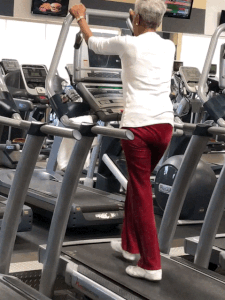
TUGGING. See if you can picture this woman comfortably walking on an inclined outdoor trail, minus the low back and leg support given by fusing her arms/hands to the machine.
This tugging or yanking – even if you think it’s subtle – will deprive the lumbar muscles from engagement.
So once again, even though your body is vertical in this case, the erector spinae are not getting the same recruitment they’d get when walking hills outdoors.
Many people just don’t get this, so hopefully, the images will help.
When de-conditioned or “out of shape” low back muscles are forced into action for your first hike of the season, you can definitely expect to feel some aching and soreness either during the hike, soon after or the day after.
Back Still Sore After Hiking Despite Using a Treadmill Incline WITHOUT Holding On?
Yes, this may happen too. It simply means that your treadmill workouts were either too infrequent or not long enough to adequately prepare the low back muscles.
The solution is to just keep on hiking and using the treadmill with a free arm swing – stay consistent.
Too many skipped workouts will not allow your spinal muscles to become as trained as you’d like.
Below are images of additional exercises that will help condition the erector spinae group for hiking.
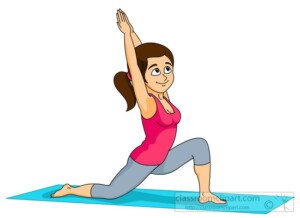


Freepik.com
 Lorra Garrick is a former personal trainer certified through the American Council on Exercise. At Bally Total Fitness she trained women and men of all ages for fat loss, muscle building, fitness and improved health.
Lorra Garrick is a former personal trainer certified through the American Council on Exercise. At Bally Total Fitness she trained women and men of all ages for fat loss, muscle building, fitness and improved health.
.


